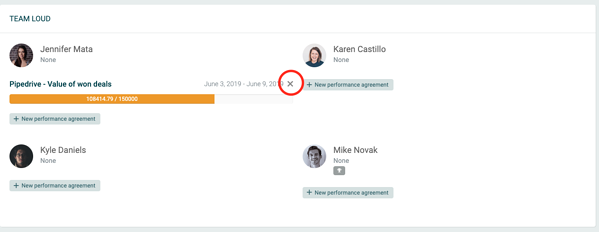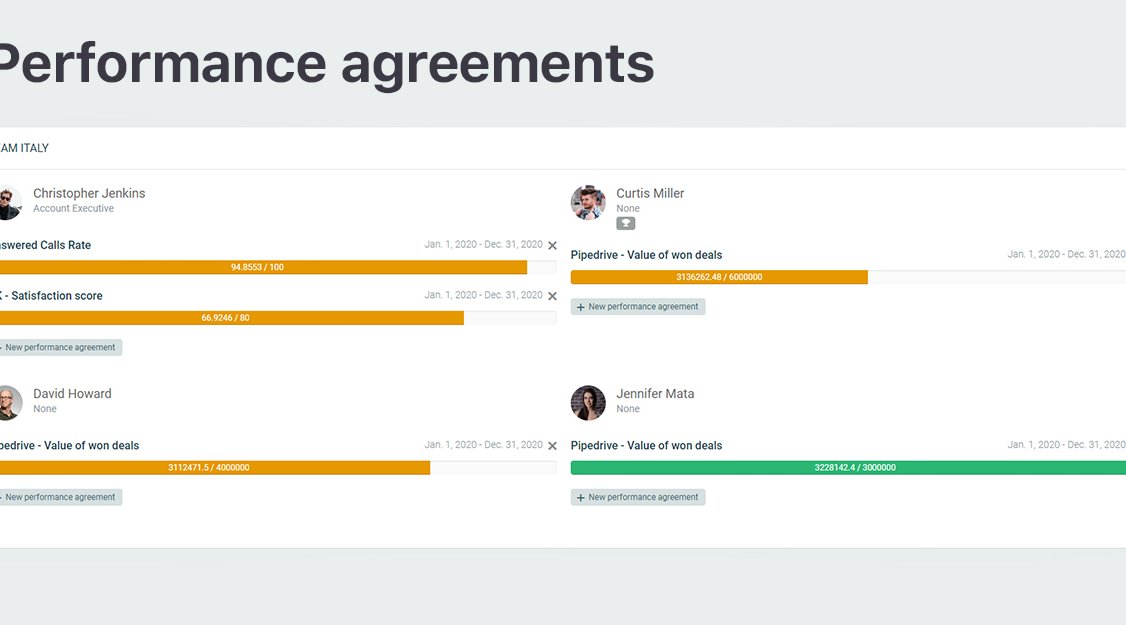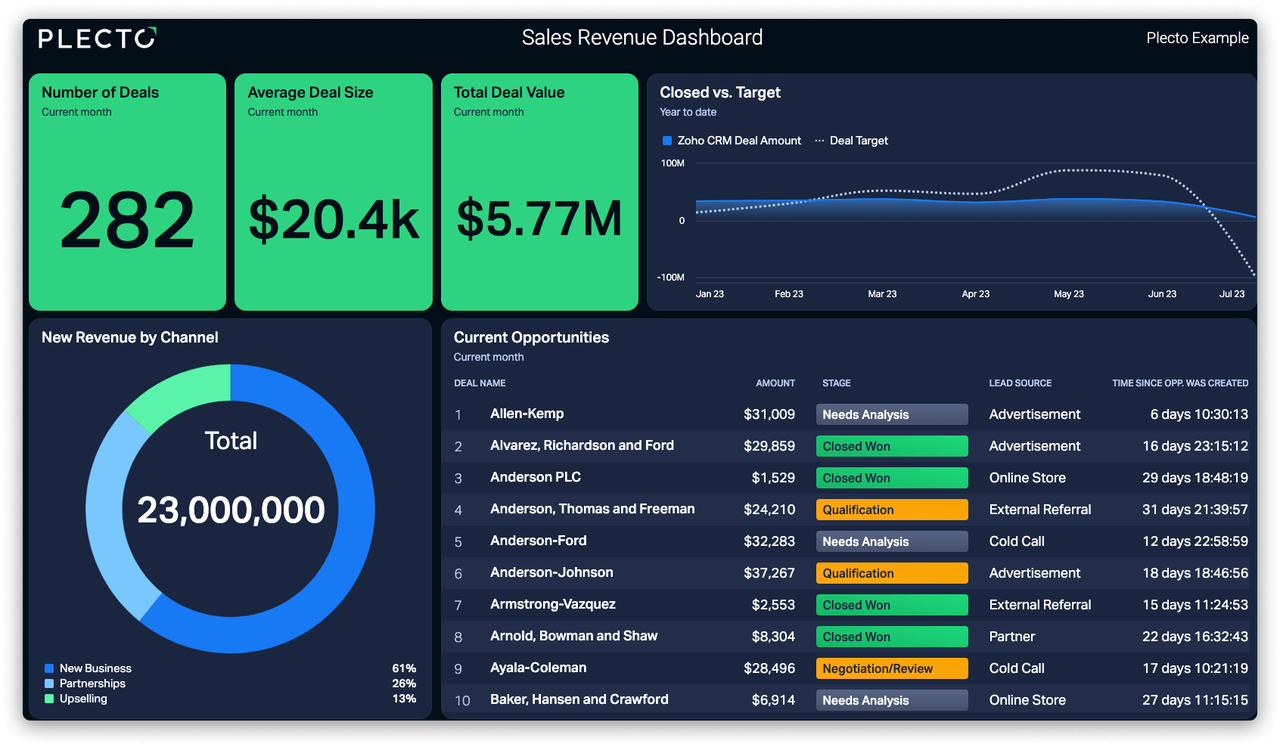First things first, let us introduce you to the feature! “Performance Agreements” is part of our coaching program, designed to help you optimize your one-on-one conversations within the Plecto platform.
The feature, therefore, allows the manager to privately set individual targets specific to each employees’ current performance so that they can individually work on optimizing it for a determined period of time.
These performance agreements are not displayed in the dashboard, because they are only visible for the manager and the specific employee.
It’s also a useful method to reinforce your employees working remotely. This feature promotes individual data-driven conversations where employees have the opportunity to focus on specific metrics they wished to improve. For this, they can agree on individual KPIs to track the progress, as well as the period of time this agreement will last for.
Motivate your employees to do better
But that’s not all! Our Performance Agreements are a great - and easy - way to motivate your employees to do better, also individually. You’re already providing your team with the best overview with the Plecto dashboards, why not also work on their individual progress?
To make it more motivating for them to follow their individual KPIs, we have also included our conditional colors to the feature. This way, the progress will be shown in different colors as they get closer to the goal - in real-time!
The best part? They own every step of the progress, which shows them how capable they are of succeeding!
You can create as many Performance Agreements as your employees need, there are no limits to work on your employees’ motivation! Moreover, you can also create notifications to inspire them to keep up their awesome work.
How do I set a “Performance Agreement”?
This is one of our easiest and fastest features to set in Plecto App! In a couple of clicks, you can have your individual KPIs up and running, only visible for you and the employee.
The best thing about setting these performance agreements is that the formulas you’d need for them are already in your system, so you just have to select them and they will automatically do the magic. Easy peasy!
You can actively use them to promote data-driven one-on-ones so that both manager and employee can get the best insight into the KPIs that might need a short-term boost to get back to usual. The idea, therefore, is for them to agree on one or two KPIs to focus on for the following weeks.
You can easily set the time period using “from” and “to” date, which will prevent the agreement from being recurrent. And since the data is already set for your dashboards, you just have to select it and you're ready to go!
Lastly, when the goal has been reached, or if you no longer need the KPI to show individually as a Performance Agreement, you can simply remove it by pressing the “x” next to the time period.

How to scale up the one-on-ones in your company
These days, 1-on-1 conversations are present in more and more companies worldwide. However, are you still unsure about how to implement them in your organization?
We’ve gathered the 3 best tips to help you optimize your one-on-ones and build a successful relationship with your employees.
One-on-ones are thought of as personalized coaching sessions for employees to improve bi-directional communication with their managers regarding performance. In this regard, the topics are always around goals, development, and barriers/motivators for performance.
Keep on reading and discover how to approach the one-on-ones in the most successful way!
1. Prepare for a flexible conversation
In a company context, meetings tend to end up following the same dynamic over and over again. However, this is one-on-one is not “another” meeting, and that’s the first thing to say when introducing it to your team.
It’s a conversation between the manager and the employee, where both of them can expect to get an outcome; in terms of new KPIs, tasks, methods, tools, or any other concern that might exist among your team.
Despite being a conversation, it still needs a structure to make sure that the relevant points are covered. For that, it’s useful for the manager to prepare for it beforehand with some bullet points of what has to be brought up, although leaving space for the employees’ input.
As the name already suggests, the one-on-ones should be held in a private place where your employees can feel comfortable enough to share their honest opinion. That’s the key purpose of this conversation in the first place!

2. Make one-on-ones a habit
It’s not going to bring you or your employees any benefit just by holding a 1-on-1 once. You all need it to be a recurrent meeting in your agendas to follow up on the points covered. Otherwise, how are you going to know if there’s any improvement?
Plus, making it a habit shows your employees that you’re making it a priority to have their point of view on the organization. Shows that you care about what they have to say and that you want to make it work. That’s all your employees ask for!
Another tip in this regard is to be transparent with the method for the one-on-one. This means that, if you’re taking notes during the conversation, the employee should also be granted access to see what’s being reported to guarantee its veracity. Moreover, you could also think about sharing the script with your employees in advance, so that they have some time to prepare what they want to mention for those topics.
So, catch up on what you need to, and help them do the same. After every one-on-one, you can share the report with them so that they also know what to focus on until the next meeting, or what to add for the next one.
3. Boost your employees’ growth
Once the bullet points about performance and results are covered, there should also be some time to focus on the employee’s growth.
Get to know what would they like to learn more about that can also help them in their job, or what are they missing to make their workplace a better place to work at.
They probably have great initiatives that would make a difference for the whole team, but they’ve never found the opportunity to share them with you. But if you give them the time and are ready to listen to them, you will be surprised!
Employees want to feel they can grow in your company, learn new things, and try different methods to stay active and up to date. And you can do that for them! As a company, you have resources that your employees could use to work on their professional development.
Provide them with the right tools, and scale up your one-on-ones!




